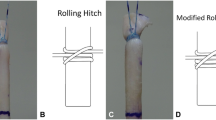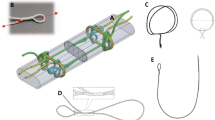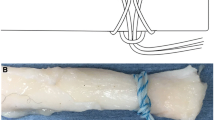Abstract
Purpose
The purpose of this study was to characterize the biomechanical effect of two grasping suture techniques used during ligament reconstruction: the modified rolling-hitch (MRH) and the modified finger-trap (MFT).
Methods
Flexor profundus tendons were harvested from fresh pig hind-leg trotters. Each specimen was mounted on an electro-mechanic universal testing machine (Instron 3367). In half of all tendons (15 specimens), the suture was passed around the tendon following the MRH knot (Group 1). In the remaining half of all tendons (15 specimens), the suture was passed over a distance of 30 mm according to the MFT suture technique (Group 2). As per standard intra-operative technique, a 1 cm residual tendon stub was left free from suture in all samples. All specimens were preconditioned to a load of 50 N for 10 min, followed by three cycles loading between 50 and 120 N. At this point, each sample was cyclically tensioned between 35 and 240 N, at 1 Hz for 200 cycles. Load-to-failure test was then carried out at a rate of 200 mm/min.
Results
Rupture of the suture material at the knot was the mode of failure in all specimens during the loaded to failure test. Significant difference was found between Group 1 vs Group 2 for the elongation between the 0th cycle and 10th cycle, the elongation between the 10th cycle and 200th cycle, the mean stiffness at the 10th cycle, and the mean stiffness at the 190th cycle. No significant differences were noted between Group 1 and Group 2 concerning the ultimate load-to-failure.
Conclusion
This study showed that both suture methods appear to be biomechanically effective in a porcine tendon model. However, the single-knot grasping technique (MRH) provided superior biomechanical properties compared with the MFT technique.




Similar content being viewed by others
References
Arneja S, McConkey MO, Mulpuri K, Chin P, Gilbart MK, Regan WD, Leith JM (2009) Graft tensioning in anterior cruciate ligament reconstruction: a systematic review of randomized controlled trials. Arthroscopy 25:200–207
Camarda L, Pitarresi G, Moscadini S, Marannano G, Sanfilippo A, D’Arienzo M (2014) Effect of suturing the femoral portion of a four-strand graft during an ACL reconstruction. Knee Surg Sports Traumatol Arthrosc 22:1040–1046
Charlick DA, Caborn DN (2000) Technical note: alternative soft-tissue graft preparation technique for cruciate ligament reconstruction. Arthroscopy 16:e20
Hahn JM, Inceoglu S, Wongworawat MD (2014) Biomechanical comparison of Krackow locking stitch versus nonlocking loop stitch with varying number of throws. Am J Sports Med 42:3003–3008
Hong C, Yeh M, Jou I, Lin C, Chang C, Su W (2015) Evaluation of 3 needleless grasping suture techniques for soft-tissue graft fixation: a porcine biomechanical study. Arthroscopy 31:1151–1155
Hong CK, Chang CH, Chiang CH, Jou IM, Su WR (2014) Hamstring graft preparation using a modified rolling hitch technique. Arthrosc Tech 3:e321–e324
Hong CK, Lin CL, Chang CH, Jou IM, Su WR (2014) Effect of the number of suture throws on the biomechanical characteristics of the suture-tendon construct. Arthroscopy 30:1609–1615
Honl M, Carrero V, Hille E, Schneider E, Morlock MM (2002) Bone-patellar tendon-bone grafts for anterior cruciate ligament reconstruction: an in vitro comparison of mechanical behavior under failure tensile loading and cyclic submaximal tensile loading. Am J Sports Med 30:549–557
Krackow KA, Thomas SC, Jones LC (1988) Ligament-tendon fixation: analysis of a new stitch and comparison with standard techniques. Orthopedics 11:909–917
Krackow KA, Thomas SC, Jones LC (1986) A new stitch for ligament-tendon fixation. Brief note. J Bone Joint Surg Am 68:764–766
Krappinger D, Kralinger FS, El Attal R, Hackl W, Haid C (2007) Modified Prusik knot versus whipstitch technique for soft tissue fixation in anterior cruciate ligament reconstruction: a biomechanical analysis. Knee Surg Sports Traumatol Arthrosc 15:418–423
Markolf KL, Gorek JF, Kabo JM, Shapiro MS (1990) Direct measurement of resultant forces in the anterior cruciate ligament. An in vitro study performed with a new experimental technique. J Bone Joint Surg Am 72:557–567
Martin DK, Falworth MS (2007) Anterior cruciate ligament graft preparation: a new and quick alternative to the whipstitch. Arthroscopy 23:326.e1–326.e3
Sakaguchi K, Tachibana Y, Oda H (2012) Biomechanical properties of porcine flexor tendon fixation with varying throws and stitch methods. Am J Sports Med 40:1641–1645
Sampatacos N, Gillette BP, Snyder SJ, Henninger HB (2016) Biomechanics of a novel technique for suprapectoral intraosseous biceps tenodesis. J Shoulder Elb Surg 25:149–157
Su WR, Chu CH, Lin CL, Lin CJ, Jou IM, Chang CW (2012) The modified finger-trap suture technique: a biomechanical comparison of a novel suture technique for graft fixation. Arthroscopy 28:702–710
Wittstein J, Wilson B, Garrett WE, Toth A (2011) Hamstring graft preparation using a needleless suture loop. J Surg Orthop Adv 20:142–144
Author information
Authors and Affiliations
Corresponding author
Ethics declarations
Conflict of interest
The authors declare that they have no conflict of interest related to the publication of this manuscript.
Rights and permissions
About this article
Cite this article
Camarda, L., Pitarresi, G., Fazzari, F. et al. Biomechanical comparison between the modified rolling-hitch and the modified finger-trap suture techniques. Arch Orthop Trauma Surg 136, 1595–1600 (2016). https://doi.org/10.1007/s00402-016-2551-4
Received:
Published:
Issue Date:
DOI: https://doi.org/10.1007/s00402-016-2551-4




